Home
Weblog
Schedule
Contact Us
Pictures
FAQ
|
« December 2005 |
| February 2006 »
Marc (a blog reader) chastized me for implying that there was something wrong with the Big RV Resort. He made some good points about the necessity of full-hookup sites for vintage trailer owners who don't have gray tanks, and the ease of taking kids to places where there are swimming pools and entertainment.
I agree, especially about the full hookups. Our 77 Argosy only had a 10 gallon gray tank, and that just didn't cut the mustard for more than a day. But on the other hand, there are nice places with full hookups and not-so-nice places.
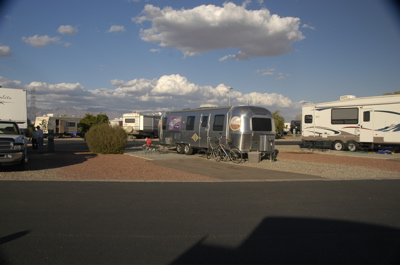
Our parking spot
The place we are in is nice in the sense that it is loaded with amenities. It's clean, comfortable, and well run. It caters to a crowd of Class A and big fifth wheel owners who want all the comforts of home. But there's nothing here other than the pool and the restaurant. It's sort of the RV equivalent of a Holiday Inn. The reason to be here is to have a home base to go somewhere else.
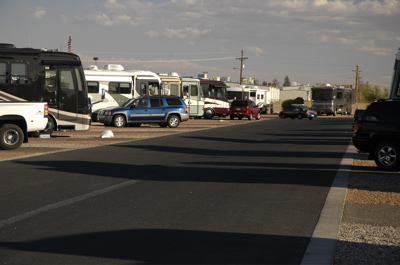
For Airstream spotters, there's not much to see. I only found one Airstream, a late-model Safari Bambi 19. The owners were out. But there are a few very impressive Class A motorhomes, including a few Prevost buses which have to cost about a million each.
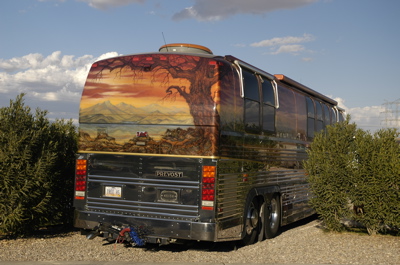
For $33 a night (Good Sam discount rate), I think we are getting a decent deal. If the pool is warm, I might even say we are getting a great deal. (We'll check that tomorrow if it's a bit warmer than today.) Normally, we seek out state and national parks that are in themselves destinations, but when visiting a city such as Tucson, the "motel" is a good way to go.
We were sorry to say goodbye to Charles and Lynn, but they sent us off in style with a nice breakfast in their 34 foot Excella. Yes, you can serve breakfast for five on an Airstream dinette -- as long as one person is flexible about where they sit.
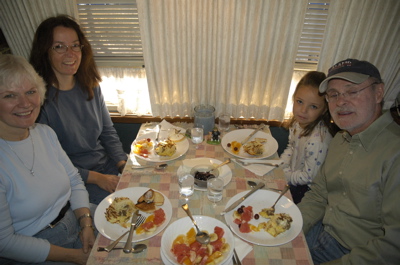
Our travel today was very short. All we needed to do was get down to Tucson, about 60 miles north and 2,000 feet lower in altitude. Because we are expecting a guest, we thought it would be a good idea to find a full-hookup campsite, so we ended up at the sort of place we don't usually go to: a Big Honkin' RV Resort.
Here are the specs: 400 sites, 266 pull-thrus. W/E/S at every site, plus cable TV, a Camping World store, a restaurant, "planned activities" (whatever those are), a mobile power-wash that comes to your site to clean your RV for $3 per foot, two swimming pools, and even some sites with personal jacuzzi tubs.
A place like this has nothing to do with communing with nature, or "getting away from it all." The Big RV Resort experience is about ... well, I don't know what it's about. It's certainly not about saving money, since most of our neighbors are in giant Class A motorhomes that cost $100-300k. Our silver trailer sticks out in this fiberglass crowd.
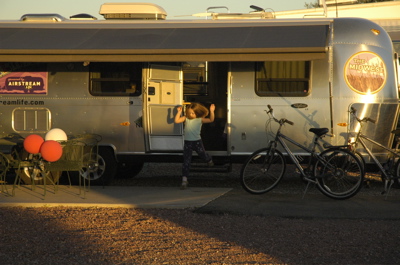
This week Eleanor and Emma are going to try to hit some of the enormous Tucson gem show going on now all over the city. Emma is a nut for rocks and minerals now, and Eleanor has become a fan of opal since our find on the California coast. I hope to join them at one or two of the venues later this week, work permitting.
Did you guess what the mining equipment in the previous post was? It was a two-seat "sanitary cart." In other words, it was the toilet. Keep in mind the temperature in the mine runs 46-52 degrees year-round, and those seats are metal. Plenty of reason to keep your bathroom break short.
About an hour’s drive east of Patagonia are Tombstone, “The town too tough to die,” and Bisbee. We left the Airstream parked at 4th and Duquesne, and Charlie reading on a park bench in the center of Patagonia, and took off for a full day of exploration.
We had been warned that Tombstone is basically a tourist trap. Imagine something like “South of the Border” with an old west theme and you’ve got it. But we wanted to take a look and give Emma a chance to see a wild west show, so we strolled down the dusty gravel street of old Tombstone.
There is some real history here, but you’ve got to look closely. There’s a state historic park in the old courthouse ($5 admission), and many houses have plaques identifying their historic status. But around town you’ll also find a lot of reproduction buildings, tons of merchants with silly names (“Pony Espresso,” “OK Café,” etc.) and people in period costumes with cell phones on their gunbelts.
It is old west history run ragged. But I should say that the locals were very nice and went out of their way to make sure everyone on the street was having a good time. And there is authenticity still alive in Tombstone. Some of the actors in the wild west show lead long trail rides up into the mountains as their primary vocations. Talking to them about their horses and their love of the open spaces made me realize the western spirit was still alive. It’s just different these days.
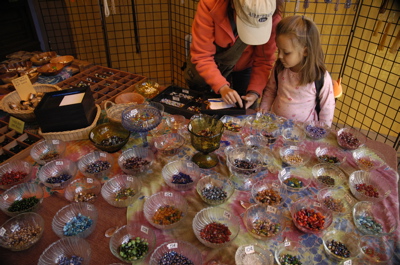
Shopping for beads in Bisbee
Still, it took only 90 minutes to feel like we’d seen enough of Tombstone (and that included 30 minutes in the wild west show), so we headed off to Bisbee, 30 miles down the road. Bisbee is a former copper mining town that now seems to be taken over by artists – which has made it an attractive and interesting place to visit, especially the downtown.
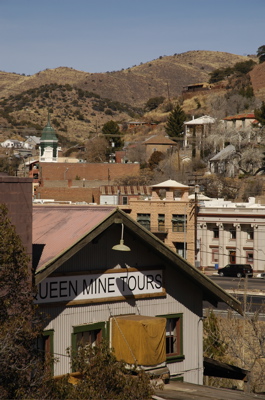
The major attraction of Bisbee is the Copper Queen Mine Tour, which takes you hundreds of feet beneath the surface of a hill to see how copper was mined from the 1800s through the middle of the 20th century. It’s a worthwhile visit, and there’s an RV park right on the premises that gives you easy walking access to downtown too.
I won’t give away too much about the mine tour, but here’s one thing you might see in there. Can you imagine what this piece of equipment is for? I’ll tell you in the next blog entry.
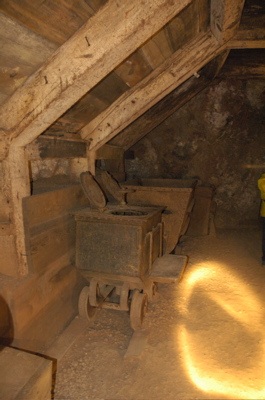
Mystery equipment in the mine?
There are two other “must see” things in Bisbee. One is the Bisbee Mining and Historical Museum, right downtown, in front of the Copper Queen Hotel. The other is The Shady Dell, a sort of campground/hotel filled with classic old aluminum travel trailers. You can spend the night in any of the restored trailers. (We featured The Shady Dell in a past issue of Airstream Life.) Amazingly, I completely spaced on The Shady Dell and forgot to drop in! Unbelievable …
There’s a lot to check out in Bisbee, so perhaps we’ll go again later this week. But we’ve got a lot on the schedule, including Kartchner Caverns, Pima Air Museum, and some great hiking. It’s going to be tough fitting it all in. Plus, we’ve got a houseguest coming on Thursday – or is that trailerguest? I’ll tell you about that later this week too.
Did I mention it’s cold here? The locals are swearing it’s just a spell, and “it hardly ever gets this cold,” but every night the low temperature seems to be lower, and three nights in a row our water hose has frozen solid.
Fortunately, it warms up nicely during the day, so Eleanor and Emma are able to walk about town and take care of business (laundry, post office, playground). They also spent half a day trying on Emma’s clothes and bringing a huge pile of stuff that she had outgrown to the local Thrift Shop. Meanwhile, I’ve been working so much in the Public Library that all the librarians know me and I have a regular space. The world headquarters of Airstream Life are at the square table by the window, first room on the left.
There’s not much in the way of grocery shopping here, so we took advice and headed 19 miles south to Nogales (AZ) to visit the big stores there. Nogales is actually a big town with all the usual big-box development. But it’s like visiting Berlin before the wall fell; the city is divided by a giant fence. Across the fence lies Mexico.
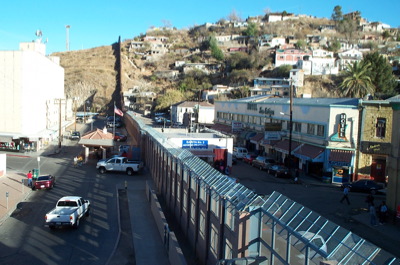
Of course we couldn’t resist taking a peek, but overall it was disappointing. If you take the lesser-known east entrance off the end of Morley Ave, you end up in a sleazy bar/massage parlor district. If you cross over the train tracks and take the west entrance by the big US Customs Building, it is exactly like downtown Tijuana: streets lined with vendors, all selling the same junk. Silver jewelry with questionable stones, pottery, prescription drugs, leather bags, dust collectors, and then they repeat over and over again.
For some reason I found myself buying a “wool” poncho made of, I believe, acrylic. Probably it was the thrill of haggling over the price that motivated me. I ended up with it for $21 and a sense that if I wore it anywhere in the southwestern states I would cause locals to snicker. The bargains are better at Wal-Mart.
Nogales will probably be our only border town experience. Frankly, once you’ve seen one, you’ve seen them all. I’m sorry now that we didn’t go through Sonoyta to Puerto Peñasco when we were in Organ Pipe Cactus National Monument. That would likely have been more interesting than Nogales, and quite a bit more authentic, too. I doubt we are going to have a similar opportunity in Texas, since our time near the border will be short. Next time we go into Mexico it will be for a much longer visit, with the Airstream (perhaps next winter!)
There isn’t much in Patagonia for Emma, so we are going to move out a couple of days earlier than planned. Sunday is set for a visit to Tombstone and Bisbee, then Monday we will move up to Tucson for hiking, museums and whatever else Tucson has to offer.
Did I mention that Patagonia is at about 4400 feet elevation? It does get pretty nippy here at night. This morning I woke up to find our water hose frozen. The hose we used (one of those roll-up types you can get at Camping World) has developed some tiny pinholes over the months, and so it acts as a sort of ground watering system. You can barely see the miniature sprays, but this morning their existence was made very clear by the little ice formations in the lawn.
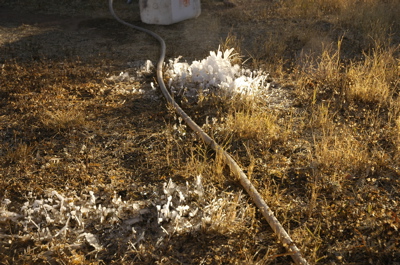
Time to get a new hose.
Over the past few days I've talked about the nearness of Mexico and how it influences life along southern Arizona. But nowhere has this been more apparent than here in Patagonia.
Because of the rugged terrain, the border here is very porous. The Border Patrol maintains a huge fleet of vehicles in the next town, Sonoita, and they have all the toys: night-vision goggles, ATVs, paddy wagons, cruisers, trucks, and helicopters. Still, I am told they catch only one in ten.
Last night while I was sitting in the dark on a bench outside the Public Library (snarfing the free wifi signal), a DEA or Border Patrol helicopter came by and began circling the town at low altitude with a multi-million candlepower spotlight. They hit me with the light a few times as they passed, in their hunt for drug runners from Mexico. Somewhere, perhaps only a few hundred feet away, someone was hiking north with a 60-lb sack of marijuana on his back, trying to evade the infrared eyes of an observer in the right seat of a Blackhawk helicopter.
It's commonplace to see Border Patrol trucks off the highway every night, spotlighting and capturing "mules" (drug couriers) and UDAs. Hike into the backcountry and you'll see piles of trash dumped where they walked the dry washes in the dark. They have no interest in Patagonia -- it's just the first of many towns they must pass to get to the American Dream. But we don't see the people themselves. They are, like the poorest third of this town, a subtle presence most of the time.
The one time they are visible is when walking south. A drug courier, having made his drop, walks home again along the roadway. At one time the Border Patrol used to pick them up and deport them, but then realized they were just becoming a free taxi service for drug runners. So now, if they spot somebody heading south, they let them keep walking.
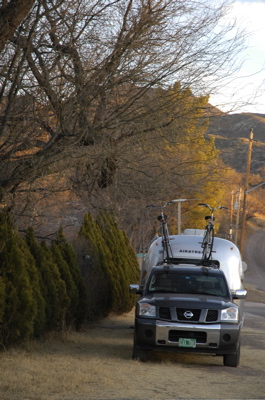
All these little intrigues go on around us, but Patagonia takes little heed. Our courtesy parking spot under the big mesquite trees on the corner of 4th and Duquesne is quiet, and we have been undisturbed. The locals slow down and stare at the trailer as they go by, but nobody has had the temerity to knock on our door yet. Still, I am reliably informed that everyone in this small town knows we are here. We may have an Open House later this weekend, just to satisfy curiousity.
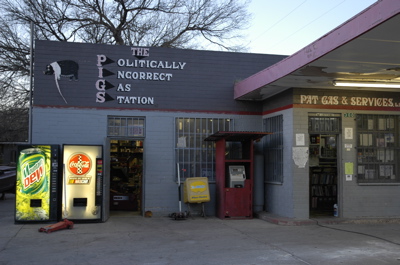
We wandered the town Wednesday night to see some of the eclectic features. There are many: the "Politically Incorrect Gas Station" (PIGS), the one-room Museum of the Dead, Velvet Elvis Pizza Parlor, Dos Palmas Vacation Resort, the combination nightclub and community center, and the backyards filled with "antiques" of all descriptions. Patagonia has layers of complexity in it that we have barely begun to appreciate. It is without a doubt the most peculiar town we have visited in the past four months.
Would you like to join us for a mini-caravan? Check our Schedule page to see where we will be in the next three months. If you can cross paths with us for a few days let us know by clicking the "Contact Us" link.
Charles was right. Patagonia is a very interesting place.
From one perspective, Patagonia is severely divided by economics. At least one-third of the community is fairly poor. You see their homes in the midst of town, sometimes neat but careworn, other times ramshackle and cluttered with decades of now-worthless possessions. It seems nearly every tiny town lot has an old travel trailer in it parked next to the house, with expired plates and cracked windows, yet often these trailers are still being inhabited full time by an in-law or cousin.
Another significant slice of the community is very wealthy. They own substantial ranches around town, and tucked up in the hills. These are multi-million dollar properties, but most are merely second homes for their owners, who fly in from California, northern Arizona, and even Austria. For some, raising cattle on these "show ranches" is probably a sideline that allows the owner to say he owns a working ranch. Others have dispensed with even that pretense and live in elaborate glass-sided architectural creations perched atop hills, surrounded by acres of mesquite trees and tall grass.
But the real story of Patagonia is its history, which permeates the place so thoroughly that a walk down the block brings up a thousand stories. Nothing in Patagonia seems new. Thankfully the town was never large enough to suffer the scourge of "urban renewal" and modernization in the 50s and 60s. Some of the locals live in adobe houses that are probably 50 or more years old. Almost everything standing is historic, and just a few miles out of town you can find the remains of abandoned mining towns that held 1,000 or more people for a few brief years.
The library, where I walk each day to borrow their free wifi, is housed in the former Patagonia Hotel, built by a former solider, John Cady, starting around 1900. He wanted to build the finest hotel of its type west of the Mississippi, and after years of expansion, he finally did it.
Across the street is a marvelous old western-fronted building with "Lopez Pool Hall" in faded paint on the facade. Next door is a beautifully restored home that has become a B&B, and across from that is the Dos Palmas "vacation home", a restored 1958 Spartan Imperial Villa permanently parked behind a fence. It's pretty cool looking from the outside. (See the website for pictures). Patagonia is a funky amalgam of artistic vision, American history, and graceful decay.
People come here for that. There are adobe houses and wonderful western-fronted storefronts are filled with artists and accomplished "dropouts" from all over the world. Late at night we see the glare from a welder who is making incredible sculptures from reinforcing steel bars. Charlie tells us stories of nearly everyone who is here: the chef from New Orleans (displaced by Hurricane Katrina), the fellow who dropped out so thoroughly his friends held a funeral for him and placed a gravestone in the local cemetary (he's still alive), the heiress with the dude ranch, the Austrian Count's wife who loves giant concrete balls, and the local fresh-vegetable cult. This place is a writer's dream, stories everywhere.
I'll post photos from all over town in a day or two. Meanwhile, I've got to catch up on the Spring magazine issue and work out some plans for our next few weeks. We will be heading to the Tucson area next week, then traveling through southern New Mexico and heading to a rendezvous in west Texas.
Before we left Organ Pipe Cactus National Monument, we stopped at the Visitor Center one last time. Emma had completed all the requirements for her first Junior Ranger certificate, so we went in to have her take the oath and receive her badge. She’s very proud of it.
The Tohono O’odham Indian Nation was quiet. Lots of open road, not much to see or visit. I didn’t score any prickly pear jam, sadly.
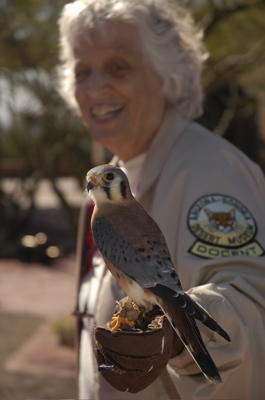
A Kestrel on the arm of a Desert Museum docent
We ended up a few hours later at the amazing Arizona Sonoran Desert Museum just west of Tucson. That place is fantastic – highly recommended. It’s a superb place for taking wildlife photos. I captured a few more hummingbird shots, as well as many other creatures and plants. (Check out the new photos I uploaded.) We stayed until closing, and then headed another two hours to our destination: Patagonia, AZ.
Why Patagonia, a off-the-beaten path western town up in the hills? I’m not sure yet. Our friends Charlie and Lynn winter here and they’ve raved about the place. It seems to be one of those rare “undiscovered” gems, far enough from the cities and off the beaten path enough that it doesn’t get a huge influx of tourists, yet genuine, historic, and friendly. So we took Charlie’s advice and came down. The offer of free courtesy parking with water and electric had nothing to do with it … but it was a nice incentive. We’ll stay until the end of January, and then relocate up to Tucson for a few days.
Looking on a map you might wonder about the remoteness of this park we’re in. We are 85 miles from Gila Bend, which is itself a dot on the interstate highway in the midst of a lot of desert. Is there anything to do here, anything to see that we haven’t seen in other desert parks (Death Valley, Joshua Tree, Anza-Borrego, Big Bend)?
The answer is of course “yes.” I am constantly amazed at the diversity of deserts. This place is nothing like Anza-Borrego (which was nearer the Mojave desert). Here we are in the Sonoran desert, the only place where the iconic Saguaro cactus grows – the one with the big arms that every associates with American deserts. In fact, there are forests of Saguaro here, along with the Organ Pipe cactus that the park is named for, and other creatures that live only in this one place.
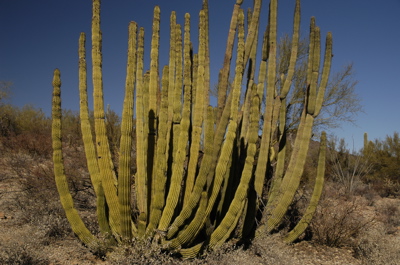
Probably the most famous is the Quitobaquito Desert Pupfish, which lives only in one place in the world, Quitobaquito Pond, a little spring just a few miles from here. Talk about endangered. This lively little fish has to survive in a little wet spot in the middle of a big desert, and if the pond has a drought, or if somebody introduces an invasive plant or animal, or if pollution gets too bad – they’re gone. The Desert Pupfish is a symbol of endangered creatures everywhere.
The Tohono O’odham Native Americans are another unique feature of this area. They have been here for centuries, and they still maintain many of their traditional practices, foods, and crafts. I am looking forward to driving through their nation on Rt 86 tomorrow. I’d like to try some of their prickly pear preserves, among other things!
In many of the desert parks you can find excellent viewing of the night sky. The stars in Anza Borrego were great, but here they are absolutely stupendous. Last night was crystal clear and the only light pollution was from Sonoyta, six miles away in Mexico. The stars were breathtaking just with the naked eye. (Too bad the temperature plunged from mid-70s to about 45 just a couple of hours after sunset!)
And finally, there’s the educational aspect of desert National Parks. No matter how many we go to, we always learn and appreciate more about the desert and the living things that have inhabited it, whether people, animals, or plants. This morning, we learned quite a bit from a simple 1.2 mile hike.
The nature of our border problems has changed some of this park. For example, roads are closed in some places. This meant we couldn’t go see Quitobaquito Pond. (But there is a small pond near the Visitor’s Center which contains a transplanted community of pupfish.)
Hiking around, we spotted a pair of large blue flags hanging off a pole. These are markers for “humanitarian stations” for undocumented aliens – e.g., emergency water for border crossers. Park staff and border patrol call them “UDAs”. Too often they show up to find a new life in America, abandoned in the desert and not carrying nearly enough water or proper clothing for a 100 mile hike through lands that routinely reach 110 degrees in the summer. At other stations, the UDAs can avail themselves of solar-powered call boxes to call for help.
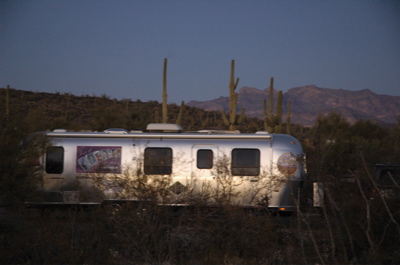
At night in the winter, the temperatures can be equally challenging. I guess we were spoiled by the mildness of Borrego Springs. Here, the wind comes up around 7 pm and the temperature plummets. We were forced to dig out all the warm clothing we have for the evening amphitheater program. We sat through “Intern Dan’s” talk while wearing two shirts, fleece, jacket, hat and gloves, and sitting on a towel to insulate against the cold benches. The rest of the audience was similarly dressed – we looked like a winter skating party.
Intern Dan gave us a fine presentation on the sounds of the desert animals. He’d play a sound and then have us guess which one it was. We were able to identify almost all of them (except the T-Rex he threw in as a curveball): great horned owl, coyote, mountain lion, Anna’s Hummingbird, javelina, even the silence of the jackrabbit. Emma, sitting in the front row, thought it was great fun.
The batteries are dead again. I ran the generator for 3.5 hours yesterday, and the batteries were mostly re-charged, but the burden of the furnace running frequently this cold night has been too much. I’m sitting here at 5:30 a.m. and I can hear from the whine of the furnace motor that we are out of power. The battery status light on the monitor panel is blinking red. We won’t be able to run the water pump this morning. Very frustrating.
We are leaving today, so I suppose I can take a shower after we are hitched up (with the truck running to supply power), but I can see we are going to have to come up with a better solution for boondocking nights in the cold desert.
All along I-8 through southern California, the nearness of Mexico is readily apparent. It lurks across the border, sometimes only a few hundred feet away, sometimes a few miles. We have seen dozens of Border Patrol vehicles along the roadside, and we have passed through checkpoints along lonely roads near Anza Borrego, Yuma, and Organ Pipe Cactus National Monument.
From I-8 you turn south at Gila Bend, a tiny desert town that one might think would forever be a speck on the desert. A great place to “eat food, get gas” before heading somewhere else. But even Gila Bend is starting to feel the impact of Phoenix’s burgeoning suburbs 50 miles away – the newspaper is printing optimistic articles about how locals stand to get rich quick selling desert tracts to Phoenix commuters.
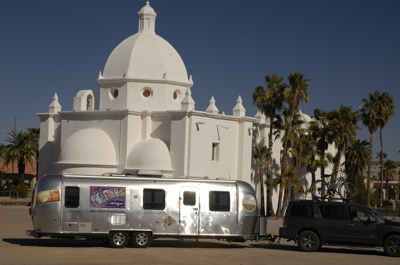
We stopped in the town of Ajo along Rt 85, expecting that it would be yet another dying desert town of the southwest. Ajo is a relic of copper mining, a town left over when the giant open-pit mine was shut down in 1985. But this little town is a surprise. It is still alive, with families enough to fill a small high school, a marvelous Spanish Colonial Revival-style plaza in the center, and a historic district filled with tiny copper miners’ bungalow homes. There is a historical museum, a downtown filled with shops, three real estate agencies, and several beautiful whitewashed stucco churches in the Mission style.
Ajo is a landlocked town, destined never to grow. It is surrounded by Air Force testing range to the north, the Cabeza Prieta National Wildlife Reserve to the east, the Tohono O’odham (Native American) Nation to the east, and Organ Pipe Cactus National Monument to the south. It’s the perfect place for someone who wants to become a desert rat, retire cheap, or who wants to live free of the pressure of rising real estate costs and sprawl. You can buy a fixer-upper for $40,000 and live in the endless sunshine and wide-open space.
The Mexican influence is apparent here, too, with “Mexican Insurance” signs all along the highway strip in Ajo, and a strong Mexican population living alongside the Border Patrol officers and Sheriff’s Department officers who make up a large portion of Ajo’s community today. Since 2001, the general beefing-up of the border has resulted in a swell of law enforcement in border towns, and Ajo is the nearest town to the crossing at Lukeville.
From the campground in Organ Pipe Cactus National Monument, we can see the lights of Mexico at night, but they are mostly from cars in the tiny border town of Sonoyta, six miles away. There’s not much on the southern side until you get to Puerto Peñasco (Rocky Point) on the Gulf of California, 60 miles away. The volunteers here in the park organize a weekly market run to get food there, which explains why the presenter at last night’s amphitheater show had fresh shrimp for dinner, here in the middle of the desert.
I was tempted to suggest we go over the border too, just for a look-see, but the nearest spot to get Mexican insurance is back in Why, 26 miles north. There’s too much to do right here in the Monument to justify spending that amount of time in the car today. We will only be here two nights before we head to Patagonia.
Our batteries are dead this morning. We boondocked in a Yuma parking lot on Friday night, and there’s no electric in this campground, so Saturday night was a second night without plugging in. Overnight temperatures here in the clear desert nights have been in the 40s. With the furnace running both nights, the batteries have been drained to a bare minimum. The refrigerator’s control board is still working, but the propane detector gave up this morning, and the water pump is pretty much not pumping anymore.
It’s clear that the trailer does not recharge well from the truck. I believe that the voltage output from the truck is not ideal for re-charging batteries. So even though we towed for three hours yesterday it didn’t do much. Even still, the generator would have saved us, but this park has unusual generator hours: noon to 4 pm. We arrived at 3:40 pm.
There’s nothing for it but to wait until noon and run the generator for the full four hours we are allowed. I’m glad we have a moderately quiet Honda eu1000i, but still I’d rather have solar. This is at least the third time we’ve been caught low on power, waiting for generator hours to get charged back up. Eleanor and I have become convinced that for full-timers who want to visit National Parks (which often do not have electric sites), there is no substitute for solar panels and a good-sized battery bank.
Hit the road today. That slow leaking tire turned out to have a nail in it. We must have got it between San Diego and Anza Borrego, because I had to put 10 lbs of air in it before we left Anza-Borrego. Fortunately, Mike has air-powered tools and big hydraulic jacks. He had that tire off in minutes, and Discount Tire put a patch in it in less than 15 minutes.
For good measure, Mike insisted on checking the torque on all our lug nuts (which were fine), increasing the air pressure to 65 psi on all tires (we were using 55 psi, but a look at the manual showed that was a bit low), and checking the battery water levels too. It's a great feeling to depart with all those things checked.
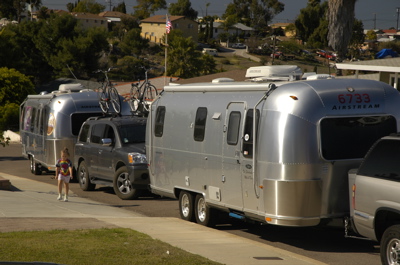
Departing Mike & Terry's in a mini-caravan
I-8 was beautiful today. Couldn't ask for nicer scenery or weather. At 4000 ft near Jacumba it was only 47 degrees, but by the time we got back down to sea level in Ocotillo it was a balmy 70 again. We parked for a couple of hours to have lunch, and to get online to book some air tickets for late March (from Florida, where we expect to be by then), and then proceeded to Yuma, AZ.
We're boondocking it at a parking lot with a bunch of other RVs for the night. Eleanor is off re-stocking our groceries with Emma while I catch up on stuff, and then tomorrow we'll head directly to Organ Pipe Cactus National Monument. It's in the middle of nowhere, right on the Mexican border, and I expect we will have neither cell phone service nor Internet, so our next update may be after the weekend. But if I can get online sooner, I'll post an update from that remote desert park.
One last day in San Diego before we hit the road again. It has been great here, and I'm sure we will return. The past week of downtime has given us a chance to reflect on what we are doing, but surprisingly there isn't much we want to change about our trip at this point. Mostly the week's hiatus gave us a chance to think about what to do next, and so we've come up with some really interesting plans that I'll tell you about later.
Mike took us over to Cabrillo National Monument for a tour, as promised. I was amazed at the stunning panoramic views of San Diego available from Point Loma!
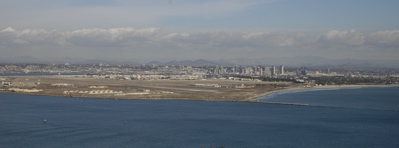
The monument is more than one might expect. There's a very interesting interpretive center with history of Cabrillo's explorations up the California coast, a Visitor Center with the awesome view, a lighthouse, grey whale-watching area, and more. While we were there, a group of docents were giving talks in period costume. It was a great visit, which we topped off with a Mexican dinner and ice cream with Mike and Terry.
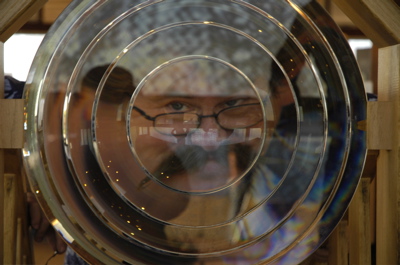
Mike looks through a fresnel lens in the Visitor's Center.
Sam Halderman, who we met in Borrego Springs, reports via email that the winds along I-8 to El Centro were fierce today. He thinks we'll find better towing conditions on Friday. If we get out there and the wind is still high, we'll have to slow down or even find a spot along the way to park overnight.
I've noticed that the rear curbside tire of the Airstream has lost a lot of air this week. We definitely have a slow leak. Mike will help me take it off tomorrow and we'll probably bring it over to the local tire shop in the morning before we hit the road. Much better to deal with it here than before we get out in the desolate stretches of I-8 in eastern California and Arizona.
OK, we're back from our break and prepping to head out again. Tomorrow we'll take the drive down I-8 and begin the first eastbound leg of our trip. But today we have a few more things to do in San Diego, including a tour of Cabrillo National Monument with Terry & Mike. Terry works there, so we are looking forward to the "insider's tour". I'll post photos late tonight or tomorrow.
Yes, he really did come all the way from France to the California desert ... and missed us! But at least he got a picture to prove he made it. I just got this via email today:

Bruno's Airstream blog can be found here. If you can't read French, just click the button that says "English version".
Without a doubt the number one question I get from working people who want to travel by RV is, "How do you get online?"
The short answer is, "Any way I can." Since we travel a lot, we can't count on any one method of Internet access to work all the time. And since getting online is absolutely mandatory for me to do my job, we do what ever it takes to find the Internet, even if it means hitching up and moving onward. Sometimes that means a compromise between where we'd like to be and where we must be.
Normally, I use a cellular Internet system called "Internet in Motion" to get online. It's basically a little black box that runs off the 12v system in the Airstream. With it, I can get online anywhere there is a cellular signal. This service costs $60 per month for unlimited use. The really nice thing about this system is that it can be left on even when in motion, so the Internet is always available. Eleanor gets online from the passenger seat while I'm towing, to look up information (weather radar, campgrounds, parks, etc). The downside, of course, is that if there's no cellular signal, it can't work.
Satellite is an excellent option for people who like to really roam to out-of-the-way places. It has the advantage of working anywhere you can see the southern sky, after about five minutes for the dish to orient itself. The equipment is more expensive-- about $5000 installed. Monthly charges are about the same as cellular. The other thing to consider is that the satellite modems require AC power, which means you have to either be plugged in or have a big battery bank and inverter.
If we can't get online with our IIM system, we run down the list of alternatives:
1) Is it really important to get online during our stay, or can we just pack the laptops and catch up later?
2) Is there a cyber cafe or other wireless hotspot nearby?
3) Can we borrow an office nearby with an Ethernet (wired) connection? Or, can we disconnect someone's computer from their Internet connection for a few minutes?
4) Does our Verizon cell phone work? If so, we can connect a cable to it and get online that way.
5) Can we borrow a phone jack and dial in? (We rarely are reduced to this level, fortunately.)
The point is that it helps to have multiple ways to get online. There are no perfect, one-size-fits-all, guaranteed ways to get online. Sometimes you'll just get skunked, as has happened to us many times. It can be frustrating that the best places to be are often the ones with no cell phone or Internet services, but we regard that as a sign that we should take a day off and go hiking!
If this sort of thing interests you, you should check out the new Digital RV Forum. It's all about digital technology in RVs. The forum just launched on December 28 2005, and I'm one of the forum moderators. Post a question there if you have one!
Frequently in online RV travel forums, someone writes to ask, “What tools should I bring with me on trips for emergency repairs?” This inevitably results in a firestorm of lists from every anal-compulsive male member of the forum, each list being bigger and better than all its predecessors, trumping and trumping again until the final toolkit is so large that it would require a trailer all its own.
I tend to take a more minimalist approach. I'll fix the basic stuff, and leave the big problems to trained professionals. (For this reason, the more important tool in my kit is the gold credit card in my wallet.) You know the basic tools we carry (duct tape, screwdrivers, rivet gun, etc), but there are a few specialized items that you'd never think of until the day you need them.
For example, we encountered our first road-borne rock in Oregon. The darned thing hit the front of the trailer like it was fired from a sniper rifle, and left a nice round half-inch ding in the driver’s side curved section of the trailer – right above the stoneguards, of course.
For this sort of metal repair, you have two choices: (1) have it repaired at enormous expense; (2) cover it up. I chose option 2, using my favorite Airstream beauty secret: the fake bullet hole.
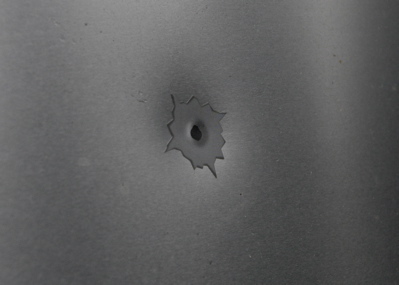
Available from " Hardley Dangerous Illusions", the fake bullet hole comes in a variety of sizes to accommodate just about any annoying ding in seconds. Best of all, with a slight indent on the trailer, the bullet hole looks remarkably realistic and provides a great conversation starter at rallies and campgrounds. I prefer the .38 calibre for general repairs.
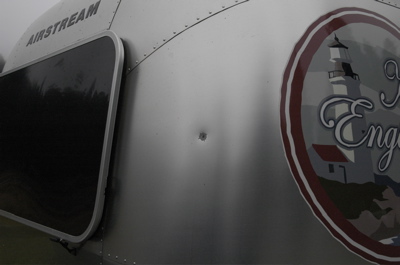
Quick and easy aluminum "repair" for $1!
Joe, a reader of this blog, wrote to us today, asking: "How do you handle laundry? That has to be a bit of a pain..."
It's not that bad. Every campground host knows where the local laundromat is. And when you're staying near larger cities like when we were in Santa Cruz, there's almost one every mile.
We pick a day to do errands. The first stop is the laundromat, where I take up three washing machines in a row (whites, lights, and darks). We head off to do a half-hour errand while the wash runs, come back, throw it in the dryer, run another errand, come back, fold and go! That way I don't spend the entire day in the laundromat and I can do two weeks worth of laundry including sheets and towels. (When we were at the beach, I did laundry once a week.) It's as simple as that.
A reader of this weblog wrote in to say:
" I know your trip is about the experience, not technical issues, but it would be interesting to know routine maintenance needed for a new Airstream on a weekly and monthly basis and your checklist for setting up camp and leaving camp."
Good questions. Actually we have remarkably little routine maintenance on the Airstream. Mostly we try to clean it periodically, inside and out. As I wrote in a previous blog entry, cleaning outside is either a matter of visiting a truck wash or borrowing a friend's driveway. It seems to need cleaning monthly, and more often when we tow near the ocean or in cities. Inside, we use a little Dirt Devil handheld vacuum and a whisk broom, along with the sort of cleaning supplies you'd use in your house. The nice thing about a trailer is that it cleans up fast, so housework amounts to about 15 minutes.
Every time we dump the holding tanks we add a little enzyme chemical and water to the empty tank, to help keep them working properly. Sometimes we add a little Calgon water softener too, to help keep things from sticking to the insides of the tanks.
Every week I check the tire pressures, check the lug nuts for tightness, and look for damage under the trailer. I also need to start checking the battery fluid levels -- haven't done that yet.
About every two or three weeks I clean the pivot points in the Reese hitch and re-lubricate them. That takes about five minutes.
A basic tool kit in the rear compartment handles any minor repairs we need to do along the way. I carry a bag full of tools and supplies: screwdrivers, rivet gun, pliers, hitch grease, pressure gauge, various kinds of tape, glue, cordless drill & bits, and spare hardware (rivets, bulbs, screws, etc). Most of it hasn't been needed -- it's just left over from when we were touring in a vintage trailer.
Pre-departure checklist is another matter. There are many details to attend to, so we have made up a two-page list. It took a few weeks to fine-tune this list (getting everything in order and dividing the work between two people). It includes things like turning off electronics, folding up the step, checking the propane, securing personal items, and closing roof vents. We'll have an article on this subject in a future issue of Airstream Life magazine, with lots more detail.
Once you get the hang of your particular trailer or motorhome, and figure out where everything goes during travel, routine maintenance and packing are a breeze. It all becomes unchallenging, like refueling your car and refilling the wiper fluid. Overall, I think it's easier than a house.
Hey, great news! Frappr has upgraded their mapping capability so now you can mark your location on our map!
Just click the link in the left column of this page that says "Click to see our map!" (you may have to scroll down to see it). When you see the map page, click the link to the right that says "Add yourself to map" and enter your name, email address and zip code. A little red pin will show up on our map that shows where you are!
You can also put in any little message you want. For example, do you own an Airstream? Do you plan to take a trip like ours? Do you have courtesy parking for us? We'd love to hear from you!
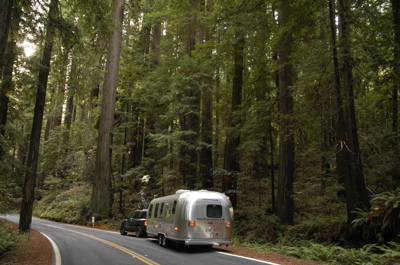
Flashback: Avenue of the Giants, near Redwood National Park, Nov 23, 2005
Since we are in vacation mode through next Wednesday, I'll take this opportunity to answer a few reader questions that come up frequently:
Airstream warranty. A reader of this blog wrote in to ask about the warranty, in light of our faucet problem back in November. The warranty is two years, bumper to bumper. We’ve had a few things fixed on the trailer and Airstream has always served us with a smile.
Tow vehicle. In November, I got a call from a Nissan dealer in North Carolina who said our photo from Wheeler Peak (Great Basin National Park) sold his customer on a Nissan Armada for his Airstream. For us, the Armada has proved to be a very good match to the 30-footer, using a properly adjusted Reese Strait-Line hitch and Prodigy brake control.
The truck has been reliable, with 10,700 miles logged since new at this point. Since we are towing a lot, we change oil every 3,000 miles. Be sure to follow the break-in instructions for towing very carefully regardless of which vehicle you buy. With the Nissan Armada or Titan, you need to log 500 miles not towing, then 500 miles towing below 45 MPH, before you hit the highway.
Email list. Down on the left column you’ll see a link that says “Enter your email and we’ll notify you of upcoming events.” Really what happens if you enter your email is that once in a while I’ll send you a note when something special is happening in the blog. For example, I'll send you a short reminder when we get back on the road next week. It won’t add you to any spam lists.
Tell a friend! If you like this blog, the best thing you can do is tell a friend! We love sharing the experience with people and we’d love to help a few more people become travelers (or enjoy traveling more)!
You may notice that I'm not updating the blog with our daily travels this week. We have elected to take a week of "vacation" and so I'm only posting non-travel bits until next Thursday.
Now, when I mention the word "vacation" I inevitably get the response, "What -- a vacation from your vacation?" So I'll explain ...
Our trip is that of a working family. I still do my day job nearly every day (7 days a week) while we are traveling in our Airstream. As I've written before, an Airstream trailer with mobile Internet, cell phones, a laptop computer, a cooperative family, and a lot of personal flexibility make this possible. I work whenever I get a chance, and see the world with my family at other times.
But there's no substitute for just unplugging. So when we started this trip, we agreed that at least once or twice we would truly disconnect from work and use the time to re-gain our perspective on everything. That's what a vacation is really about, for me. I don't want to remember my Airstream year only as a time when I was constantly scrambling to balance the obligations of family and work.
I think the obligations we have taken with us are the key difference between us and retirees. The goal of being retired, for many people, is to have most of the responsibilities of work and family behind you, so that you can roam the country without care. We still have those responsibilities but are unwilling to wait until we are retired to travel, so this is our compromise.
In that sense, we are travelers, not vacationers. It works for us. Life goes on, with all its minor dramas and trials, every day we are in our Airstream, but we enjoy our lives more and suffer the trials less because we are simultaneously doing what we love: seeing America on our terms.
Next week we will go back to our regular program of work and travel. But this week, through next Wednesday, we are just a family on vacation. I'll let you know what other perspectives I have gained, when we get back. In the meantime, I will post at least every other day, with some answers to your questions and lifestyle tips we've accumulated over the past two months.
You asked for them, you got them! I just uploaded a new album to Flickr with a bunch more photos of our 1952 Cruiser project. You'll see it's pretty rough inside, but wait ... in six months this trailer will be awesome!
Rob is towing it up to Plattsburgh later this month so Colin's team at GSM Vehicles can get started on it. We'll start a separate blog for it around then. The plan is to have it ready for the International Rally in Salem Oregon by late June. Not much time! We'll have to hustle.
OK, I'll confess today .... I bought another Airstream last Saturday.
It's a fixer-upper, over fifty years old. It's going to be the next Airstream Life magazine project trailer. We are tenatively calling it "Project Vintage Lightning" (in homage to "our first project").
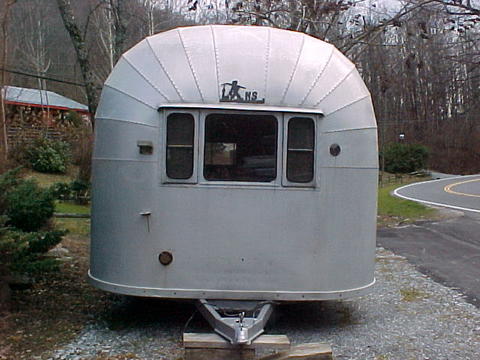
The trailer is a 1952 Airstream Cruiser, 25 feet long. Richard Tedesco in North Carolina found it for us. It has some very cool 50s features, including the "sunburst" 13-panel front and rear domes, and a Zolatone painted interior. Of course, we're going to do a total makeover on it, so when it is done it will be a beautiful showpiece, polished and outfitted with all kinds of cool goodies.
For you Airstream fanatics (like me): this is the only example we know of a 1950s Cruiser with two axles! It's a California trailer, and we are working on discovering its history right now. I'll report on that later. My only clue to its history at this point is a 1962 California title.
By the way, now you know why I was checking out that 1953 Airstream Cruiser we were parked next to back on December 3 in Santa Cruz ... (The owner of that one wouldn't sell.)
I'm very excited about this trailer. Not only does it have terrific potential, we have partnered with GSM Vehicles in Plattsburgh NY for a professional refurbishing. GSM Vehicles did my 1968 Caravel, and is currently working on Rob Baker's "1958 Sovereign of the Road", and will soon start on Steve Hingtgen's "1956 Caravanner". So we expect great things.
We hope to have it ready for the 2006 International Rally in Salem OR (late June). We'll tour it around a bit in the summer and fall, and then it will be sold to some lucky person. Should be a sweet ride!
It was a beautiful day for towing over the mountains, but Julian was a bust. It's not the sort of place one wants to be wandering around with a 30-foot trailer in tow. The whole town is basically on a hillside, and long parking spaces on level ground are non-existent.
We inquired locally about the gold mine, and were told we might be able to visit it with our trailer, but that turned out to be terrible advice. The road in was rutted dirt, one-lane, and without any sort of respectable turnaround. We arrived at the entrance gate to see a sign advising us that tours for adults were $10, children were $5, and "if you cross this line, you owe!"
At that point we just wanted to get our trailer out in one piece. After an exciting three-point maneuver (with barbed wire fencing to add to the fun), we reversed course and carefully picked out a path between the potholes back to the main road. Ah, well, not everything works out the way you'd want it to.
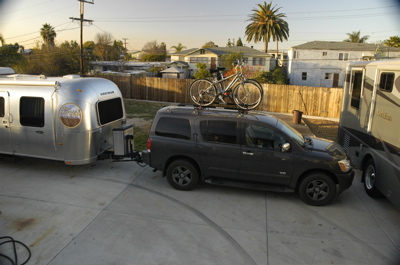
We've arrived at Terry and Mike's house in San Diego for courtesy parking. Their extended family seems to own half the block, and they've combined backyards to create a private parking area for their various projects. After a little vehicle shuffling to make room, we got a nice spot on a concrete pad with electricity and fencing all around. Private, quiet, free ... three of the the things that make courtesy parking great!
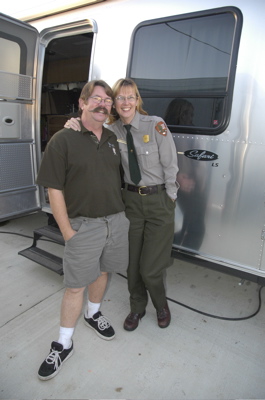
Terry is an occasional writer for Airstream Life. Can you guess what her day job is? Her husband possesses one of the most elaborate mustaches I have seen since Salvador Dali. Together they are quite a pair, and I'm not even mentioning Terry's fetish for Tinkerbell dolls (oops, sorry Terry). We loved having chili dinner with them tonight, and Emma loved meeting their niece, cat, and two dogs.
We'll be here for over a week. The rest of this week and next, I will be posting some tips and answers to your questions here, about every other day. Then, we'll start heading east next Thursday or Friday.
Regretfully today is our departure day from Anza Borrego Desert State Park. This visit is definitely going to be one of our favorite stops in the entire tour, and I think we are all sorry to have to leave after only eight days.
Right now we are packing up in prep for our haul back over the mountains to San Diego. There's a lot of pack up: bicycles, chairs, firewood, office equipment, etc. We don't usually spread out so much during a stop, but this was a relatively long one.
If we can, we will stop in Julian on the way over, at 4000 ft. Tonight we'll meet up with some Airstream friends and courtesy park. I hope it's not raining over there. California has been getting drenched but we've had warm temperatures and sunshine every day. It will be an adjustment to go back to real weather!
The longer we stay in Borrego Springs, the more we discover. The history and geography of Anza-Borrego is so extensive that it has spawned several thick books. And the "hidden" parts of the park are just enormous.
We took a hike yesterday morning to spot some bighorn sheep. Four trips to Anza-Borrego and I've never seen one, although they are very common in the hills here. After a mile of hiking we saw a ram and a ewe leaping from rock to rock at an unbelievable speed. It was all I could do to get my camera pointed and firing before they disappeared. Even at three shots per second, I only managed to get a few images.
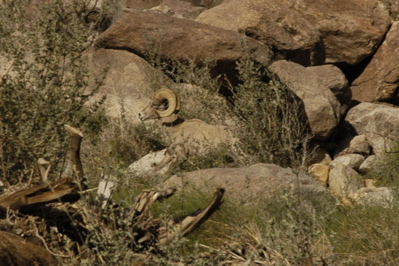
You can see how well camouflaged these animals are. If it weren't for their rapid movement, we probably wouldn't have spotted them at all. Although we stayed out for another hour on the trail, we didn't spot any others. This pair managed to double back and sneak past us (by climbing high into the hills) later. I am amazed the mountain lions ever manage to catch one.
Saturday I also dropped in on an ranger talk about the Carrizo Gorge Railroad, which passes through this park to the south. Eleanor and I had hiked about six miles of the inactive railroad bed back in the mid-90s (where we had a surprising encounter with a group of nudists, but that's another story). I wanted to find out why the railroad was ever built, since it was an impossibly twisty route with over fifteen tunnels and enormous bridges made of 8x10 redwood posts.
Turns out the railroad was an unprofitable disaster since it opened in 1919. Floods, derailments, tunnel collapses, Mexican bandits, and many other problems occurred over the decades. It was finally abandoned in 1983, but in 2003 the County of San Diego announced plans to bring it back. Now it is being policed and we can't hike it anymore, which is a shame since it is an amazingly scenic trail.
Last night we went to a campfire talk with another ranger. The subject was the Fish Creek parcel of the park, where we went offroading on Friday. The talk really rounded out our experience. Whenever we are in national parks, we aim for the ranger talks because they give you an appreciation and understanding of the place that you can't get by just wandering around with a trail map.
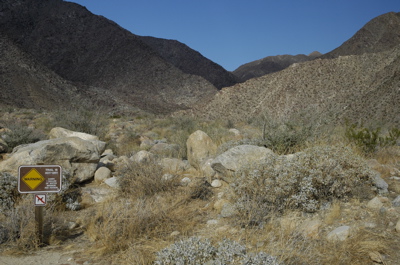
Our Saturday morning hike. Trailhead sign says, "Trail is HOT - DRY. Bring one gallon of water per person."
What a beautiful day today! Pure sunshine, 80 degrees, dry and gorgeous. We stayed close to home to relax and catch up on some work. But I took an opportunity to catch our hummingbird friends in flight, over by the Camp Host's hummingbird feeder. After just five minutes of waiting, this lovely couple showed up.
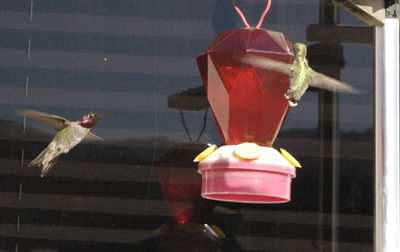
These are "Anna's Hummingbirds," which I suspect are the same as the "Costa's Hummingbird" but I haven't checked yet.
Sorry the photo is so grainy. I had to crank the camera up to 1600 ISO (in full sun!) to even catch this much. This was shot at 1/640th of a second, f13. Those little birds are fast! I'll post more photos on the Flickr album later tomorrow.
Remember back in early December when we stopped at Tim Shepard's house for a night of courtesy parking and an interview? Well, you can listen to the podcast now, on your computer. Just go to www.thevap.com and download Episode 9! You don't need any special software.
In the podcast, Eleanor and I talk about living on the road, planning, budgeting, getting along, vintage vs. new, packing, laundry, and more.
OK, we have had our offroading experiences. The Nissan is now, uh, "broken in" (a few scratches), and we've learned what it is all about.
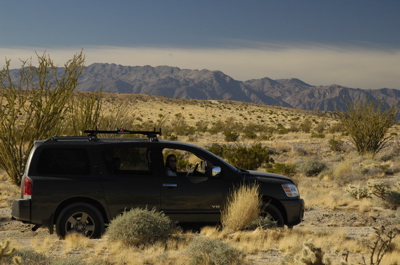
Yesterday we spent the afternoon checking out a slot canyon which is only reachable by 4wd road. You drive about two miles and then climb down into the canyon. The canyons go for miles sometimes. Serious fun!
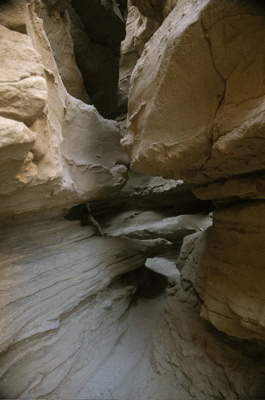
Later, we took the scenic route through a few rocky washes (dry creeks), and found some SERIOUS off-roading spots. I wish I had a picture of us going down a steep rutted slope in 4WD LO, but at the time our thoughts were mostly of survival. The roads can go from sandy tracks to "mountain goat required" in an instant. In fact, the road with the steep descent was called "Goat Trail". It should have been a clue! Fortunately, most of our routes were fun and easy driving.
At one point, driving down a rocky wash, Eleanor asked if we could get the Airstream in there. Uh, probably not. But it would be a very cool place to camp -- very isolated, very private, very pretty.
We topped off the evening with a campfire cookout, and then I had to get to work. I've been working early mornings and late evenings so I can get the most out of the sunny days. If you see me on AOL IM late at night, that's why. (My AOL screenname is "rluhr" -- feel free to say Hi sometime.)
Today we snuck out of the "office" at 11 and headed out for more exploring. This time we hit a 4wd road that leads to "Wind caves", which are sandstone deposits eroded by the wind into interesting formations. On the way, we passed through a large canyon. Those canyons are magical. Fossilized mollusks make up some of the walls, along with sandstone, desert flowers, even bees. There's always something to stop and take a look at.
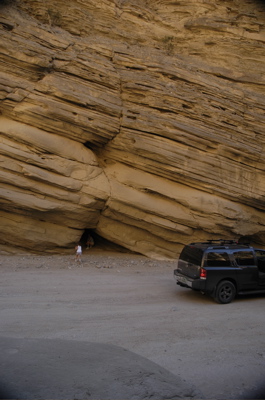
The wind caves are a one-mile hike from the road (mostly up), and it was the perfect day for it: sunny, 80 degrees, light breeze, dry. And the views from the top were spectacular.
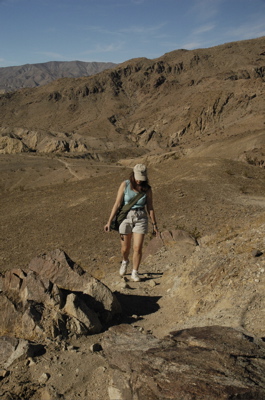
The caves are small but perfect for kids to climb in and around. I checked them for scorpions and similar critters, but they were all empty except for sand.
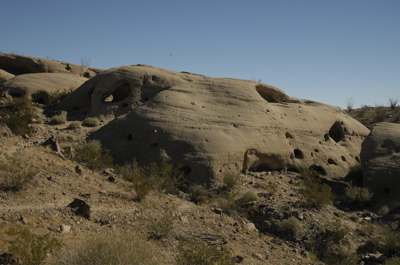
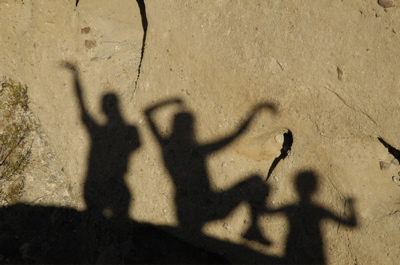
We did manage to uncover some interesting symbols drawn on the rock.
Our final venture was to Sandstone Canyon, which was extremely interesting at times. In the photo below we've just come out of one of the deep winding slots. But this spot was easy. At times we had to fold up the side mirrors and watch both sides to make sure we could fit! We did pretty well until we reached a spot where it was too technical to continue. I had to back out for about 100 feet, and unfortunately scraped the front lower bumper a bit along the sandstone. Oh well.
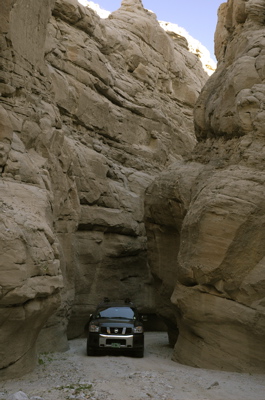
Back at camp, we found a note from Bruno Accart, a subscriber and blog reader from France. Bruno and his family are in southern California on their annual vacation. Unfortunately, Bruno lost my phone number and so he couldn't call today to tell me he was coming for a visit. He sent a note through this website but I didn't get it until I got home. By then, there was a note on our door: "Hi to Rich & you family. Bruno and Leila were here ... but not you. Maybe for the next time. Bruno & Leila -- FRANCE --"
Sorry Bruno! I tried to call you back but my mobile phone wouldn't let me call your mobile phone because your phone number is in France. If you see this -- give me a call at 1-802-877-2900. I have a t-shirt here for you!
The campground was full this weekend, for the New Year's Eve gatherings. But now that the crowds of RV'ers have departed, the park has fallen into a quieter state. Every morning I hear dozens of tiny birds chirping birds in the smoke trees and the fan palms. The purple-headed Costa's Hummingbird whips by too, so quickly that we often don't see it, but we hear the loud hum, like a giant bumblebee.
The campground is now half full, with retiree snowbirds doing whatever it is they do. We don't see many of them. After dark a few can be spotted sitting by a campfire with friends, but most of them seem to retreat inside to watch TV on their satellite dishes.
After dark I stood in the desert watching the sky for a while. It was the first clear night we have had since we got here. The Milky Way was splashed overhead and a crescent moon was framed by the big fan palms to our southwest. I could hear a night bird screaming overhead as it patrolled the campground, undoubtedly looking for a rodent to eat.
The town has gone quiet, too. Borrego Springs is basically defined by a central road that heads east-west. At the west, it dead-ends into the State Park headquarters and campground, where we live now. A mile further west and you'd hit the mountains, but there are no roads past the campground. To the east, we have a mile of not much, then a small strip of downtown.
We pass the quiet town on the way to anything else in the park. Gas $2.69, then an RV resort, an Inn, a couple of strip malls (grocery, lawyer, gifts, tacos, post office), a little Mexican market, real estate office, laundry, and the centerpiece of town: "Christmas Circle".
Christmas Circle is just a rotary with a patch of grass in the middle and a visitor center. To the north there are a few scattered subdivisions, to the east a few miles there is an airport, and to the south there is a slowly rising road called S3 (and later S22) that you can drive for 50 miles without leaving the desert park.
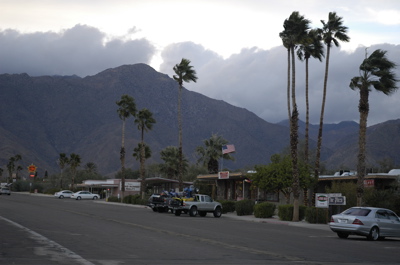
Being here now is like lingering after a big party. The place seems empty, but really, emptiness is its natural state. To someone who wants excitement, there is "nothing to do." But if you look more closely, there is too much to do. Once I finish some work, we will hopefully have time to do some more exploring today.
Our life in the desert has been full. Yesterday you may have noticed I didn't blog at all. We decided to take a day off to recuperate. I'm dealing with a small post-cold infection, which is clearing up by itself, and Eleanor is definitely fighting off something, probably my virus. So we slept as late as we could, stayed home and just enjoyed the desert sunshine, with nothing more strenuous than a short bike ride around the camp.
On our quiet day, we were pleased indeed to be visited by blog readers Bill and Beth Kerfoot. They drove two hours from their home near Los Angeles to come show us pictures of their really cool 1954 Airstream Liner, which is undergoing a major restoration. AND they brought us lemon cake and cookies! (Way to go, Bill & Beth. You guys are welcome anytime! )
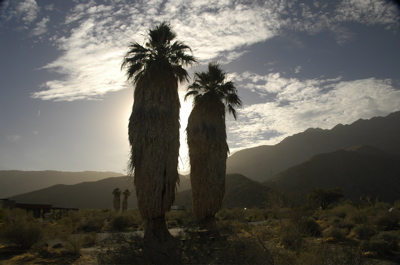
The Kerfoots spent the afternoon and left just before sunset, not long after I took this photo of the two friendly fan palms that guard our Airstream. We settled in for a quick evening campfire (marshmallows for Emma and Eleanor), dinner, a movie, and hit the sack early.
Today was the day for weather. Heavy rain has reached most of California, so we arrived in the desert just in time. Even here, gusty winds and occasional rain showers have been coming and going all day, but in the desert rain is such an event that it doesn't seem bothersome. I took down the awning, stowed anything loose, and then went for a bike ride ...
... whereupon I met up with Sam and Annette Halderman, another pair of loyal blog readers. These folks were camped just a few rows away from us in their fairly new Airstream Safari 25. Sam told me they had been meaning to catch up with us at Sweetwater Summit but the timing didn't work. So, they found us here!
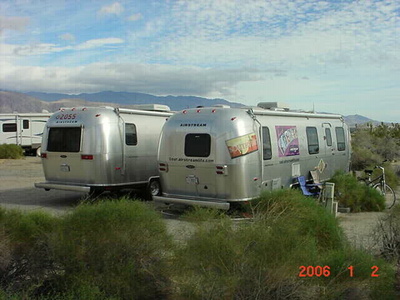
As they left, the Halderman's posed their Safari next to ours!
I love when we meet people because of this blog! Sam and Annette gave me a pile of great info about the Tucson area (where we will be heading in a couple of weeks) and we talked about all things Airstream until I got called away to go attend a bat talk at the Visitor's Center with E&E. The bat talk was fascinating and the Visitor's Center has been re-done since our last visit -- it is really top-notch now.
By the time we got back, the rainbows had arrived, which I posted below already. The changing desert light and clouds made for some spectacular scenery.
Trying to continue taking it easy, we decided to go off-roading for the afternoon. The Nissan has never been off road and it certainly is capable enough (when not towing an Airstream). The folks at the Visitor's Center suggested a few routes for us to try, starting with Palo Verde, about ten miles east.
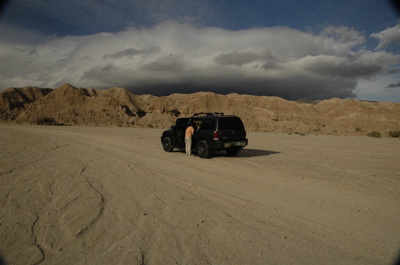
Great fun! The route wasn't seriously challenging (mostly soft sand), but the scenery and geology were terrific. In the photo above you can see Eleanor unloading Emma at one of our stops, along a wide dry wash called "Short Wash".
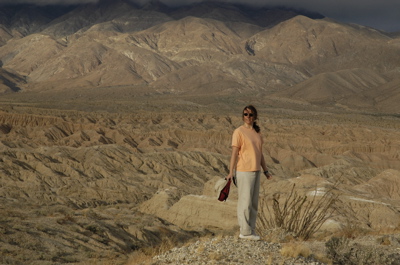
A later stop at Vista Del Malpais yielded some incredible views into the Anza-Borrego badlands. I've been to Anza Borrego four times and never seen this part of the park. The effect of standing up on the vista with the wind whipping at perhaps 30 MPH, and the badlands hundreds of feet below is just elating. It's like a miniature Grand Canyon. I've never seen anything like it.
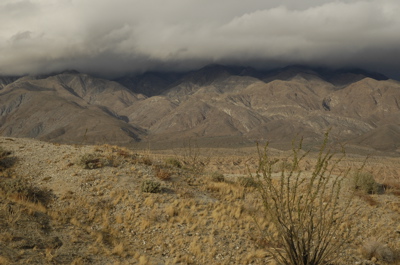
I have learned from today that the desert is at its most dramatic when clouds arrive. Shadows on the mountains, rainbows, gray streaks of cloud dipping down, dust storms on the horizon -- all these things enhance the visual experience of the desert in ways one can hardly imagine. And you have to be looking all the time, because no view lasts for more than a few minutes. I shot over 100 photos today and had to restrain myself from shooting dozens more.
After our off-road adventure, we stopped by some of the random spots where people are camping. Anza-Borrego is almost unique in that camping is allowed almost anywhere. Just pull up and set up your tent, or park your RV. Stay as long as you want.
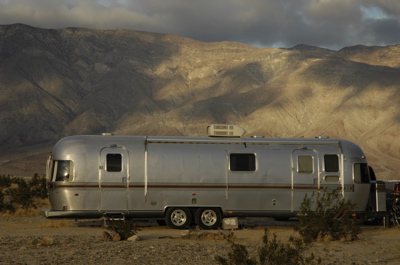
So that's what RV'ers do. Everywhere, scattered across 50 miles of parkland, you will find RVs in the most unlikely spots, completely isolated, sitting in the desert. There are no services (except that cell phones work near Borrego Springs.) No water, no electricity, no 911. But still hundreds of RVs are to be found, including many Airstreams, such as the unusual double-door Classic Limited we saw (above).
I talked to one of the Airstreamers who does this, and he told me he had been out there for over a month. The last two weeks he had his mother (80-plus years old) along. She has been Airstreaming for 23 years and knows more about boondocking than most of us will ever learn. They conserve water scrupulously, making a 50 gallon tank last for at least two weeks. Solar panels on the roof give him enough power to run a microwave once a day, watch two hours of TV on his satellite dish (there are four channels here but all are from Mexico and hence only in Spanish), and run his coffee maker, lights, water pump, etc. When the water is low, he pays $6 to come into the state park, refill, dump the holding tanks, take a shower, and he's good again for another couple of weeks. If he needs something, all the services of Borrego Springs are only six miles away.
Cost of living? $6 every two weeks, plus food. All the scenery you can stand, and plenty of jackrabbits (and fellow RV'ers) for company. You could do worse.
I like it here.
We are about to go off-roading for the afternoon, but as we were preparing to leave a bit of rain arrived and yielded a glorious rainbow over the desert. Emma and I grabbed our cameras and ran out. The rain was pelting us but drying almost as quickly. I got a few shots -- here's one.
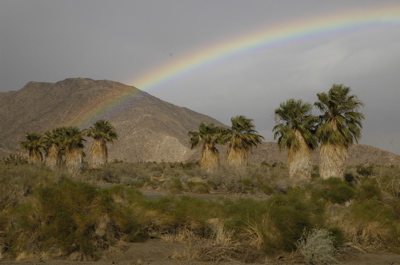
The wind is gusty (15-25 most of the time but occasionally we get a monster gust that rocks the trailer) and the rain keeps coming and going. The sun is shining at the same time, so it's a little bizarre. Desert weather.
I'll report in later about our 4WD experience, our Airstream visitors yesterday and today, and the bat talk we went to this morning.
|










































